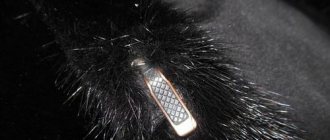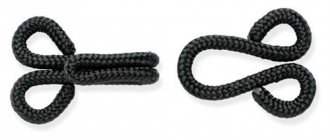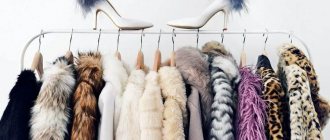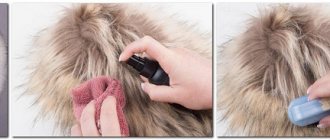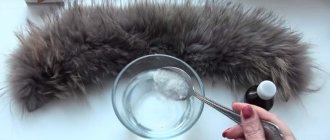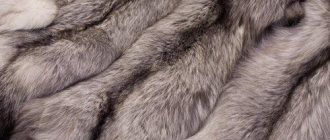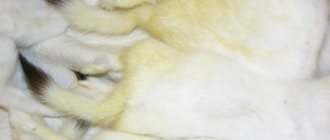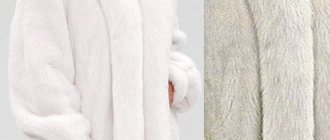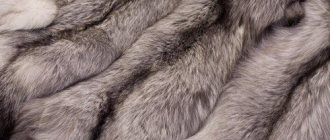A fur coat is a favorite item of clothing for many women. This piece of clothing speaks about the status of the owner. If a woman is wearing a natural fur coat, this means that her material income is above average. In addition, the undeniable advantage of a mink coat is its beauty and excellent user qualities. In this version of outerwear it is not cold, even in the most severe frosts. In a fur coat, both the quality of the fur dressing and the lining are important. How to properly clean this part of a fur product? It’s no secret that the quality of cleaning the lining determines whether the fur coat will emit an unpleasant odor. Often, it is the insufficient processing of the lining material that causes the release of an unpleasant aroma from a fur product.
Lining
Cleaning correctly
The basic rule to remember is that the lining for the mink coat in the photo is cleaned separately from the product itself. This means that before cleaning, the lining material is peeled off from the fur coat and cleaned using other methods. Of course, you can without hesitation take your fur item to the dry cleaner, where experienced craftsmen will carry out all the necessary manipulations. But every housewife can clean the lining of a fur coat on her own at home.
First you need to assess the degree and area of contamination of the product. Usually this is the lower part of the fur coat. Accordingly, at the same time as the fur, the lining material becomes contaminated. To clean the fabric, lay the fur coat on a flat surface and carefully wash the lining with soapy water and a sponge. Afterwards, wipe the surface with a damp, clean cloth, and then with a dry soft cloth. The product does not require further manipulation. It is only necessary to dry the product without resorting to mechanical methods. The best solution is drying at room temperature.
Fur headphones
To make these headphones you will need:
- scissors;
- black rim;
- felt fabric;
- artificial fur;
- hot melt adhesive.
Using scissors, cut out two interconnected circles from the fabric. Fur is applied to only one side of the circle. The eights are folded and the batting is placed inside. The rim is glued along the contour. The headphones are ready. They can be decorated with a brooch, rhinestones, bows.
Cleaning with tear-off
If the lining material is heavily soiled over the entire surface, then the previous method will not be suitable for high-quality cleaning. In this case, you will have to tear off the lining and clean it separately from the fur coat.
It is not difficult to carry out this manipulation at home. It is recommended to purchase small scissors or a special steamer. After carefully stripping, the lining material should be soaked in a warm soapy solution. If there are greasy, greasy stains on the fabric, ammonia will help remove them. After thoroughly rinsing the product in warm water, the lining should be dried naturally, without the use of hair dryers or other heating devices.
Fur pillow
This beauty will decorate any sofa. And don’t despair if you don’t have cutting and sewing courses under your belt. There would be desire, patience, free time and an old fur coat. You need to choose the shape and size of the pillow yourself.
The list of everything needed is as follows:
- thick paper;
- scissors;
- needle;
- threads;
- ruler;
- snake;
- stuffing material;
- sewing machine;
- decorative details;
- pieces of fur, leatherette or leather, felt, fleece.
Before making a pattern, you need to decide on the dimensions of the finished product. It is worth keeping in mind that the stuffed finished pillow will be smaller than the pattern, so you need to add 3-4 centimeters to each edge, not counting the seam allowances.
A pillow of the correct geometric shape is cut out quite simply. A figure with the appropriate dimensions is drawn on thick paper, cut out and applied to the fur. Three sides of the figure are sewn on a machine, the fourth is left for sewing in the snake. Afterwards the pillow is filled with padding polyester or foam rubber. If you have feathers, you can use those too.
Square pillow pattern
In the same way, you can make a pillow from thick fabric, decorating it with fur inserts or decorative elements.
Sew on the lining
After thorough drying and ironing, the lining material in the photo should be sewn back to the fur coat. This should be done with a neat, inconspicuous seam. If during the washing process it turns out that the material is not suitable for further use, it is better to replace it with a new one. To do this, you can cut out a lining from a new material or seek help from a studio. To change the lining of a fur coat with your own hands at home, you should know what material is suitable for this product.
How to sew a lining to a fur coat is shown in the video.
Fur bag
A fairly common item among fashionistas, especially considering that such beauty is made in a single copy. The handbag can be either miniature or quite spacious, solid or with patchwork inserts. This piece will also be decorated with fur accessories that never go out of style.
To make a bag you need to get:
- fur patches;
- a sheet of cardboard or whatman paper;
- zipper;
- chalk or soap (for drawing details);
- lining fabric;
- scissors;
- thread and needle.
A pattern is made from whatman paper. It is good to use pieces of leather, which are perfectly combined with fur patches and make the handbag more durable.
The instructions for making such a product are elementary. A pattern is prepared in the sizes you need. Pieces of fur with seam allowances are cut out using patterns. Heavily worn and holey places are avoided. All flaps are sewn together, the lining is sewn on, taking into account the handles and zipper. If the fur interferes with fastening the snake, it must be cut short in that area. You can decorate the handbag with other pieces of fur, straps, clasps and other decorative details.
Suitable material
Replacing the lining for a fur coat in the photo, the process is not complicated. What fabric is suitable for sewing a new lining? It should be a soft, pleasant to the touch fabric. It can be natural silk or material with the addition of synthetics. Masters say that the best choice is to choose a combined fabric. The material for the lining must be durable so that the service life of the product is as long as possible. You should not buy 100% synthetic fabric to sew a lining for a mink coat. Despite its strength, this material is not pleasant to the touch, is slippery, and does not retain comfortable warmth.
In custody
To keep your mink coat clean, it is very important to clean the lining material in a timely manner. You can do this at home with your own hands. To do this, first, the fabric is peeled off from the product. After cleaning and drying, you should sew the lining to the fur coat. If the fabric is not subject to further use, it is recommended to purchase new material from which a new lining is cut out and sewn.
Leave your comment:
Rug made from an old fur coat
A very necessary thing in the house. Moreover, rugs can be both large and small, of regular geometric shape or completely free of it. The most correct option is to place such a rug next to the bed so that when you wake up, you place your feet not on the cold floor, but on a warm and soft bedding. This will not only lift your spirits, but also make the climb more enjoyable.
Carpets can be made oval, square, round, in the shape of flowers or hunting trophies. The set of tools should be the same as in the previous version. The scraps are cut out, sewn together, and a lining is made. You can even leave worn areas. They will give the product a certain charm.
Some seams need to be taped
Some areas of fur clothing need to be duplicated, for example, hem, collar, hem and others. Duplicating with cushioning material will protect them from stretching and give them the required shape. It is imperative to strengthen connecting seams such as armhole seams, neck seams, and shoulder seams. These areas are subject to stretching and the tape sewn into the seam strengthens and strengthens it. In sewing accessories stores you can buy regular cotton tape 1.5-2cm wide and use it for these purposes. There are also special adhesive tapes, which furriers call “amplifiers.” They are also used when sewing products made from genuine leather. The tape is placed on one side.
Fur coat patterns and transfer of patterns onto canvas
For a fur coat, it’s easiest to take a ready-made one, but you can use coat patterns of different silhouettes. As soon as the pattern is printed or transferred from a magazine to paper, you can begin to transfer the patterns onto the material.
Faux fur coat
If a fur coat is made from faux fur , then you need to pay attention to the following rules for working with the material:
- To transfer patterns onto faux fur fabric, it is necessary to take into account that a long pile is cut in its direction, while a short pile can be cut in any direction.
- Sew down eco-fur parts with straight stitches, after which on the front side along the seams, pull out the pile from the seams with a needle or ripper.
- Excess fur, if it is long and thick, must be removed from the allowances by cutting it off.
- Details of faux fur products are not duplicated with adhesive-based materials to avoid damage to the main fabric.
- Excess volume in the hem areas is removed by heat treatment.
- It is not recommended to subject artificial fur to wet heat treatment , but if there is a special need, for example, to iron the seams, you can heat treat the areas without steam and the iron - a piece of natural fabric, usually cotton, white. The iron should be slightly heated during operation.
- If the base material is thin and is not able to hold its shape on its own, then it is recommended to reinforce the edges and shoulder seams with strips of cotton fabric so that the seams do not creep. In this case, the product must have a lining.
Do not forget that if the fur has a pattern, then there is a need to adjust it at the stage of laying out the patterns.
Natural fur coat
Working with natural fur involves the following steps:
- Since working with natural fur requires a certain set of skills, it is better to first practice on an old, worn product that you can find at home or purchase at a flea market.
- Parts made of natural fur must be sewn either by hand or on a special furrier's machine, since ordinary household machines will greatly stretch the seams or tear the fabric.
- To sew any product made from natural fur, you need to connect the skins together, unfold them and straighten the seam, then tap the seams thoroughly with a hammer from the wrong side. This is done in order to obtain smooth and flat seams, the edges of which fit perfectly together.
4. If there is a slight difference in the length of the pile on the skins being joined , then the problem can be solved by moving the skin with a longer pile upward. Then you should tighten the stitches well.
5. Hand stitches are made with a slight slack, and all stitches should be made with the same tension.
6. To avoid deformation of some areas or parts of the fur coat , it is necessary to duplicate them with cushioning material.
7. All seams that have a large load, for example, shoulder, armhole or neck seams, must be additionally reinforced with cotton tapes.
8. Fur coats connected to each other are stretched on a wooden surface using small nails and a hammer, while the fabric is first slightly moistened with water from the reverse side. This operation allows you to align the seams and the skins themselves, and also, in some cases, increase the size of the fabric.
9. The joints of the skins are processed with a special metal comb.
10. The skins must match in pile consistency, length and shade.
Pattern pattern for a fur coat with a stand-up collar:
It is better to look at models of fur coats made from natural fur in catalogs. Mink coats with a stand-up collar look stylish. Long scarves and stoles look impressive on them, which can be tied differently every day, creating a new look.
Important! Please note that the skins are cut exclusively using a blade or a special shoe knife, but in no case with scissors, which damage the fur itself; this also applies to artificial material.
Faux fur short fur coat
When all the details of the fur coat are transferred to the fur fabric and cut out, you can start working:
- the same patterns from which we cut out the main parts to the lining and, if there is insulation, do not forget about the allowances for stitching, we cut them out.
- We sew down the details of the fur coat on a machine . The allowances need to be trimmed a little so that they are invisible.
- We assemble and sew down the lining alone or with insulation . We process the edges using an overlocker.
- It's time to attach the main piece to the lining . To do this, we fold the parts face to face, secure them with pins, insert the sleeve lining into the base sleeve and sew them on a machine. Then we grind down the neck and side sections of the shelf.
- Turn the product right side out.
- Using a needle, we pull out all the fur caught in the stitches with a needle and comb the fur coat well.
- Carefully process the bottom cut of the product.
Now all that remains is the hardware you have chosen . It is best to use either sewn-on buttons or buttons with loops as fasteners in such fur coats, and you can also sew on hooks.
The product is ready!

